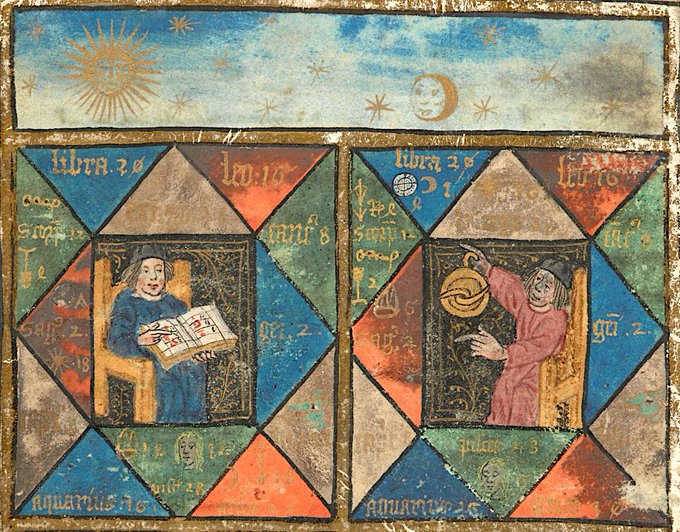Astrological figures suitable for the different stages of the preparation of the Philosopher's Stone; the 2 figures have been identified as Thomas Norton & Edward IV (f.67v), in Thomas Norton's, "Ordinal of Alchemy," late 15thC @britishlibrary @BLMedieval https://t.co/53OZu5lUFk
Krishna and his family admire a solar eclipse, folio from a Bhagavata Purana, India, Himachal Pradesh, Kangra, 1775–80 @FreerSackler https://t.co/ns3e9Ex0Xq
'View from the Surface of the Moon', in Robert Ball's "In Starry Realms" (Bath, UK, 1908) @BioDivLibrary https://t.co/OWFcKLMWTS
Omen of the misfortunes of Jerusalem by the appearance of a comet, in "L'Istoire de Josephus", French translation by Guillermus Coquillart, 1463 (f.178r, Français 406) @GallicaBnF https://t.co/ZklqKMuHou
Astronomical playing cards with constellations, published by John Lenthall, London, c. 1717 @BeineckeLibrary https://t.co/eLEGXQf4U7
Diagram of the phases of the Moon (f.62r), in Johannes de Sacrobosco's, "Computus", 1230-1399 @britishlibrary @BLMedieval https://t.co/dZWPM0K2di
Korean painting of the Tejaprabha Buddha and the North Pole star, surrounded by figures representing the navagraha (9 planets), 28 constellations and 12 western signs of the zodiac; mineral colors on coarse silk; Joseon Dynasty, 1850-60 @britishmuseum https://t.co/XJquGsp6jJ
Astronomical diagrams from Leonardo de Pierio Dati's "Sferamundi" c.1475 @WellcomeLibrary https://t.co/nIl3y7ibEV
The constellation of Draco in a "Catalogue of Stars extracted from Ptolemy's Almagest in the Latin translation of Gerard of Cremona," Arundel MS 66 (f. 33v), 1490 @BLMedieval @britishlibrary https://t.co/YbIANvyfyY
Google celebrates John Harrison’s 325th Birthday https://t.co/9NBd2JbzHk
















